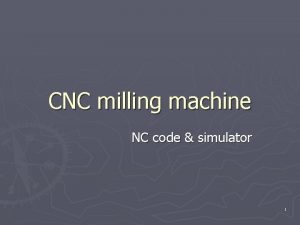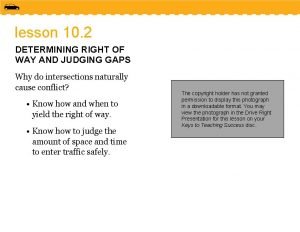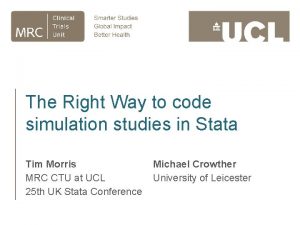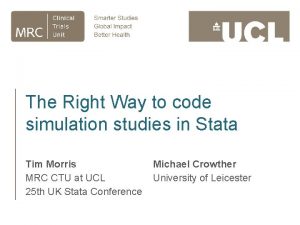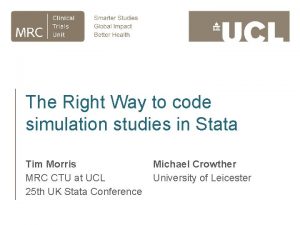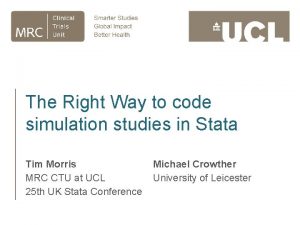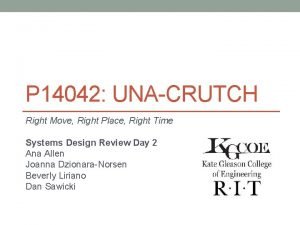The Right Way to code simulation studies in


















- Slides: 18

The Right Way to code simulation studies in Stata Tim Morris MRC CTU at UCL 25 th UK Stata Conference Michael Crowther University of Leicester

https: //github. com/tpmorris/The. Right. Way tldr: Michael’s way is unambiguously wrong My way is not unambiguously right The Right Way is unambiguously right MRC CTU at UCL

What is a simulation study? • MRC CTU at UCL

Some background • Consistent terminology with definitions • ADEMP (Aims, Data-generating mechanisms, Estimands, Methods, Performance measures): D, E, M are important in coding simulation studies MRC CTU at UCL

Four datasets (possibly) • MRC CTU at UCL

This talk focuses on the code that produces a simulated dataset and returns the estimates and states datasets. I teach simulation studies a lot. Errors in coding occur primarily in generating data in the way you want, and in storing summaries of each repetition (estimates data). MRC CTU at UCL

A simple simulation study: Aims Suppose we are interested in the analysis of a randomised trial with a survival outcome and unknown baseline hazard function. Aim to evaluate the impacts of: 1. misspecifying the baseline hazard function on the estimate of the treatment effect 2. fitting a more complex model than necessary 3. avoiding the issue by using a semiparametric model MRC CTU at UCL

Data generating mechanisms • MRC CTU at UCL

Estimands and Methods • MRC CTU at UCL

Well-structured estimates Long–long format rep_id 1 1 1 n_obs 100 100 100 500 500 500 truegamma γ=1 γ=1. 5 γ=1. 5 Inputs method Exponential Weibull Cox theta_hat -1. 690183 -1. 712495 -1. 688541 -. 5390697 -. 6375546 -. 6162164 -. 5785365 -. 5820988 -. 5867053 -. 4040936 -. 4308287 -. 4335943 se. 5477225. 54808. 5481199. 2495417. 2504361. 2510851. 1548867. 1549543. 1550035. 1188226. 1189563. 1190354 Results MRC CTU at UCL

Well-structured estimates Wide–long format rep_id n_obs gamma theta_exp se_exp theta_wei se_wei theta_cox se_cox 1 100 γ=1 -1. 690183 . 5477225 -1. 712495 . 54808 -1. 688541 . 54811 1 100 1. 5 -. 5164924 . 2589072 -. 5594682 . 2595417 -. 5601631 . 25988 1 500 γ=1 -. 6253604 . 1511858 -. 6269046 . 1512856 -. 6343831 . 15134 1 500 1. 5 -. 478514 . 1176905 -. 5447887 . 1179448 -. 5460246 . 11803 2 100 γ=1 -. 377425 . 3562627 -. 3859514 . 3563656 -. 3728753 . 35644 2 100 1. 5 -. 4841157 . 2456835 -. 5684879 . 2466851 -. 5850977 . 24722 2 500 γ=1 -. 6477997 . 1615617 -. 6477113 . 161647 -. 6452857 . 16166 2 500 1. 5 -. 3358569 . 1222584 -. 3609435 . 1223288 -. 3619137 . 12240 Inputs Results MRC CTU at UCL

The simulate approach From the help file: ‘simulate eases the programming task of performing Monte Carlo-type simulations’ … ‘questionable’ to ‘no’. MRC CTU at UCL

The simulate approach If you haven’t used it, simulate works as follows: 1. You write a program (rclass or eclass) that follows standard Stata syntax and returns quantities of interest as scalars. 2. Your program will generate ≥ 1 simulated dataset and return estimates for ≥ 1 estimands obtained by ≥ 1 methods. 3. You use simulate to repeatedly call the program. MRC CTU at UCL

The simulate approach I’ve wished-&-grumbled here and on Statalist that simulate: – Does not allow posting of the repetition number (an oversight? ) – Precludes putting strings into the estimates dataset, meaning non-numerical inputs (D) and contents of c(rngstate) cannot be stored. – Produces ultra-wide data (if E, M and D vary, the resulting estimates must be stored across a single row!) Your code is clean; your estimates dataset is a mess. MRC CTU at UCL

The post approach Structure: tempname tim postfile `tim' int(rep) str 5(dgm estimand) /// double(theta se) using estimates. dta, replace forval i = 1/`nsim' { <1 st DGM> <apply method> post `tim' (`i') ("thing") ("theta") (_b[trt]) > (_se[trt]) <2 nd DGM> } postclose `tim' MRC CTU at UCL

The post approach + No shortcomings of simulate + Produces a well-formed estimates dataset – post commands become entangled in the code for generating and analysing data – post lines are more error prone. Suppose you are using different n. An efficient way to code this is to generate a dataset (with n observations) and then increase subsets of this data in analysis for the ‘smaller n’ data-generating mechanisms. The code can get inelegant and you mis-post. Your estimates dataset is clean; your code is a mess. MRC CTU at UCL

The right approach One can mash-up the two! 1. Write a program, as you would with simulate 2. Use postfile 3. Call the program 4. Post inputs and returned results using post 5. Use a second postfile for storing rngstates Why? 1. Appease Michael: Tidy code that is less error-prone. 2. Appease Tim: Tidy estimates (and states) dataset that avoids error-prone reshaping & formatting acrobatics. MRC CTU at UCL

A query (grumble? ) • None of the options allow for a well-formatted dataset. I want to define a (unique) sort order, label variables & values, use chars… (for value labels, order matters; see below) • I believe this stuff has to be done afterwards (? ) • To use 1 "Exponential" 2 "Weibull" and 3 "Cox" (I do), I have to open estimates. dta, label define and label values. Could this be done up-front so you could e. g. fill in DGM codes with “Cox”: method_label rather than number 2? MRC CTU at UCL
 Right product right place right time right price
Right product right place right time right price Right time right place right quantity right quality
Right time right place right quantity right quality The right man on the right place at the right time
The right man on the right place at the right time Code commit code build code deploy
Code commit code build code deploy Paradigm shift from women studies to gender studies
Paradigm shift from women studies to gender studies Cnc simulator code
Cnc simulator code Frequency trig
Frequency trig Perbedaan one way dan two way anova
Perbedaan one way dan two way anova Advantage of threaded binary tree
Advantage of threaded binary tree Perbedaan anova one way and two way
Perbedaan anova one way and two way Anova test
Anova test One way anova vs two way anova
One way anova vs two way anova Apa itu two way anova
Apa itu two way anova Conventional software
Conventional software A bottle of rum to fill my tum
A bottle of rum to fill my tum Talk this way
Talk this way Loop whorl arch
Loop whorl arch Right of way herbicides
Right of way herbicides Right of way
Right of way





